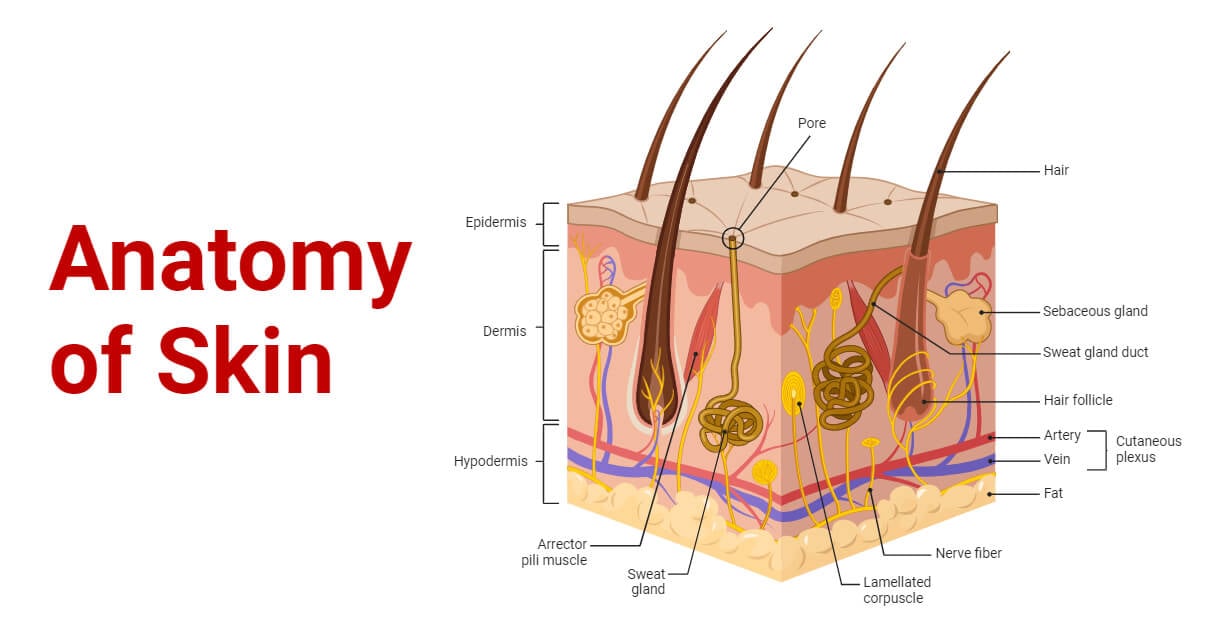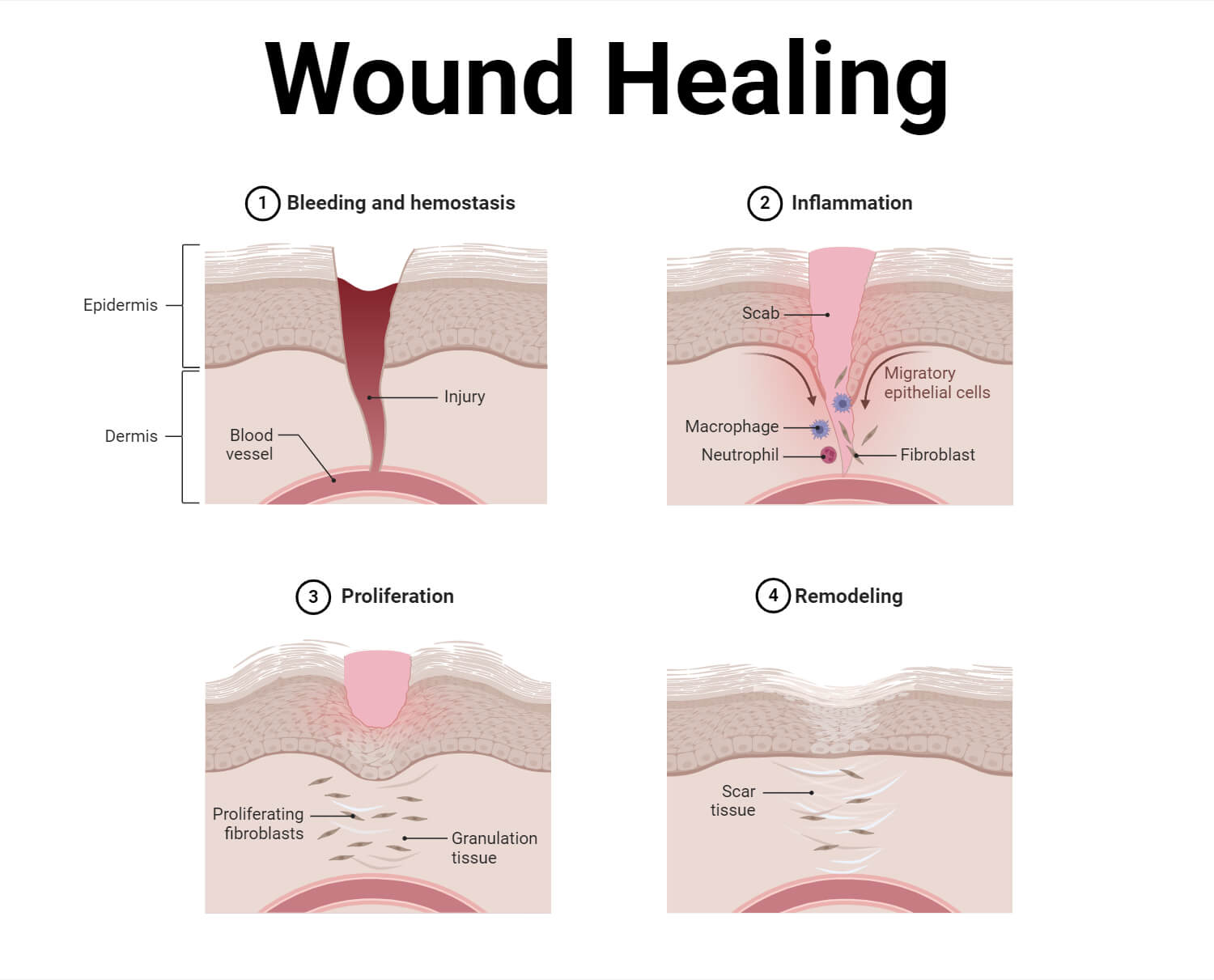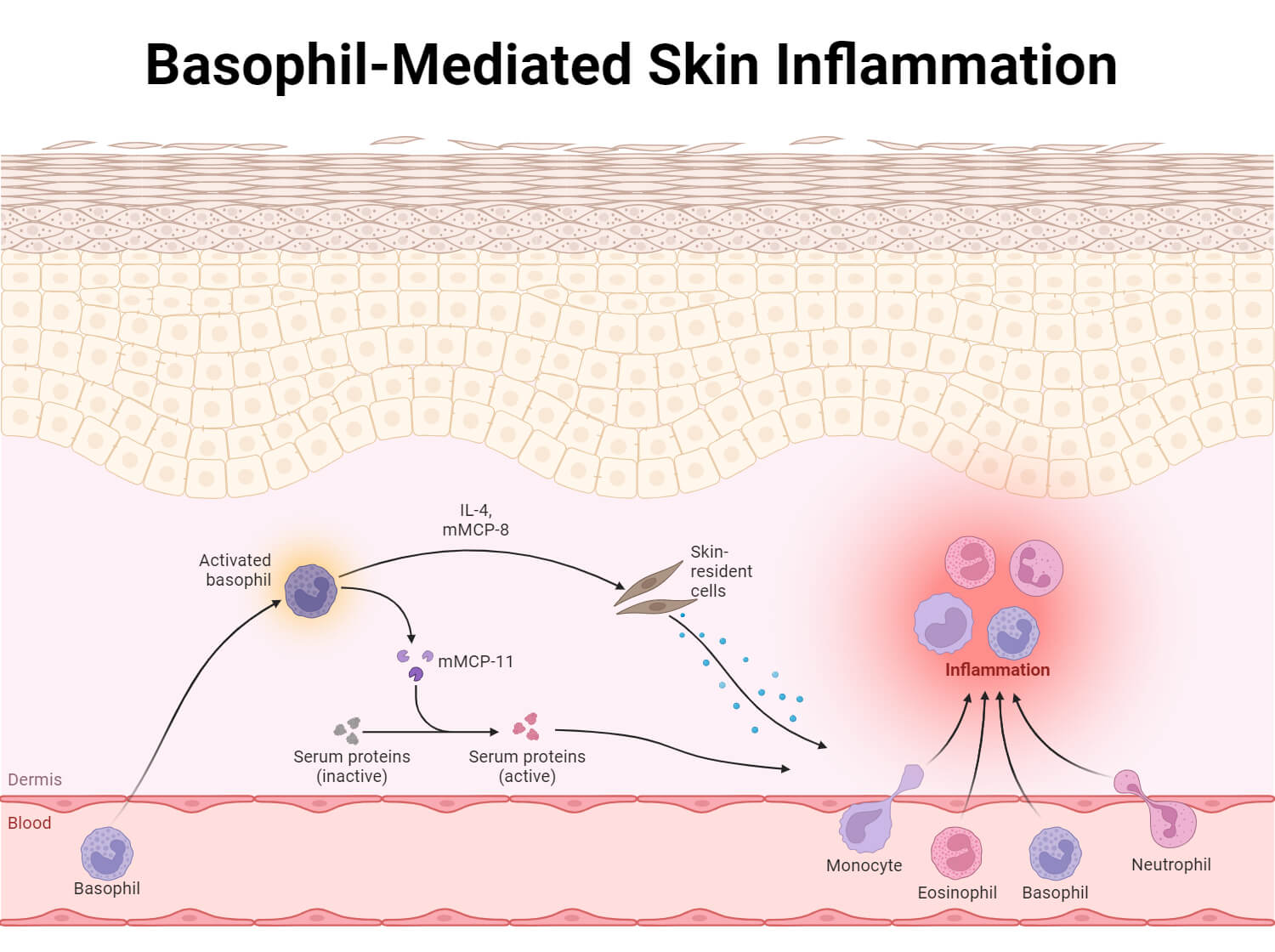Skin cells are the building blocks of our skin, which is the largest organ of the body. The skin is the outer covering of the body that acts as the protective barrier against the external environment and performs various other vital functions in the body.
The skin contains different layers that are composed of different types of cells. Together, the layers and cells of the skin create a complex organ that provides protection and helps in the regulation of different body functions.
Interesting Science Videos
Anatomy and Structure of Skin
The skin contains three layers of tissue: Epidermis, Dermis, and Hypodermis.
- The epidermis is the outermost layer of the skin that contains different types of cells including Keratinocytes, Melanocytes, Langerhans cells, and Merkel cells. There are four main layers of skin cells in the epidermis. Starting from the surface, the layers of the epidermis are the stratum corneum, stratum granulosum, stratum spinosum, and stratum basale. In areas with thick skin, like the palms and soles, there is an additional layer called the stratum lucidum found beneath the stratum corneum.
- The dermis is the layer of the skin that lies under the epidermis. This layer contains connective tissue, blood vessels, nerves, hair follicles, and various specialized cells including fibroblast, macrophages, mast cells, adipocytes, and stem cells. This layer is further divided into two layers: the papillary layer and the reticular layer.
- The hypodermis or subcutaneous layer lies under the dermis and forms the deepest layer of the skin. It is composed mainly of adipose cells and connective tissue which provides insulation and energy storage. It connects the skin to muscles and bones.

Types of Skin Cells
The skin contains several types of cells. The four main types of skin cells found in the epidermis are:
- Keratinocytes are the most common type of cell found in the epidermis. They produce the protein keratin, which provides strength to the skin. Keratinocytes are produced from the basal cells in the innermost layer of the epidermis and move to the surface in a process called keratinization. As these cells move toward the surface, they eventually die and form the outer protective layer of dead skin cells.
- Melanocytes are cells found in the lower layer of the epidermis that produce melanin, which is a pigment responsible for skin color and protects the skin against harmful UV radiation. Melanocytes originate from the neural crest cells. These cells transfer pigment granules to neighboring keratinocytes through structures called dendrites.
- Langerhans cells are immune cells found in the stratum spinosum layer of the epidermis. These cells are dendritic cells involved in the immune response. They detect and alert the immune system to potential threats. These cells originate from mesenchymal cells. These cells carry antigens from the skin to the lymph nodes to alert the immune system.
- Merkel cells are oval-shaped skin cells found in the stratum basale layer of the epidermis. These cells function as touch receptors and are involved in sensory perception. This allows us to sense different stimuli such as touch and pressure. They are attached to keratinocytes by structures known as desmosomes.
The inner dermis and hypodermis layer also contain other specialized cells.
- The dermis contains different cells like fibroblasts, macrophages, and mast cells. Fibroblasts are cells that produce fibers like collagen and elastin that provide the skin its strength and elasticity. Macrophages are immune cells that engulf pathogens and other foreign substances. Mast cells are also immune cells involved in the immune and inflammatory response of the body.
- The hypodermis layer mainly consists of adipose cells or adipocytes. These cells store energy as fat and provide insulation for the body.
Functions of Skin Cells
- Keratinocytes produce the protein keratin, which forms a tough barrier on the surface of the skin. This barrier protects the internal organs from pathogens and injury. Keratin provides strength and structure to the skin. Keratinocytes also play a role in immune response and wound healing.

- Melanocytes produce melanin pigment that provides pigmentation or skin color. These cells also protect against UV radiation.
- Langerhans cells take up foreign antigens and transport them to the lymph node to induce an immune response to the antigens. This immune response defends against foreign invaders.
- Merkel cells function as mechanoreceptors, helping sense stimuli such as touch, pain, and temperature. These cells convert mechanical stimuli into electrical signals and transmit these signals to the sensory nerve fibers.
- Macrophages found in the dermis of the skin engulf pathogens, regulate inflammation, promote tissue repair, and maintain tissue homeostasis.
- Mast cells are involved in immune responses and inflammation. These cells contain several receptors that detect pathogens and tissue damage in the skin. Mast cells communicate using mediators such as histamine and cytokines.
Diseases and Disorders of Skin Cells
- Basal cell carcinoma is a common type of skin cancer that arises in the basal cells of the epidermis layer. It mainly occurs on sun-exposed skin. It is a slow-growing tumor that is less likely to metastasize. It usually occurs as a small, shiny bump on the skin. The primary cause of basal cell carcinoma is a change or mutation in the DNA of the skin cells that occurs due to exposure to ultraviolet (UV) rays. Primary treatment methods involve excision, cryosurgery, photodynamic therapy, or laser therapy. Several protective measures can be adopted to reduce the risk including minimizing sun exposure, avoiding tanning beds, using sunscreen, wearing protective clothing, and quitting smoking.
- Squamous cell carcinoma is another most common type of skin cancer following basal cell carcinoma. It starts in the squamous cells which are flat keratinocytes. It also mainly develops in sun-exposed parts of the body. The main cause of squamous cell carcinoma is a mutation in the p53 gene due to long-term exposure to UV radiation. Other factors causing squamous cell carcinoma include a weak immune system, old age, and exposure to certain chemicals. The primary treatment for squamous cell carcinoma is surgery. Other treatment options include the use of oral or topical retinoids to reduce the risk of squamous cell carcinoma development.
- Melanomas are a rare type of skin cancer that arises in the melanocytes. They have a high potential to metastasize. Melanoma may occur as moles, unusual bumps, scaly patches, sores, or rashes. The main cause of melanoma is exposure to UV rays. Other risk factors for melanoma include a history of melanoma, fair skin, use of tanning beds, and weak immune system. Treatment for melanoma includes surgery, targeted cancer therapy, and immunotherapy.
- Langerhans Cell Histiocytosis (LCH) is a type of rare cancer where Langerhans cells build up in the body. It primarily affects children. It can cause tissue damage and lesion formation in various parts of the body. Genetic mutations in genes like BRAF, along with environmental factors and infections can cause LCH. Risk factors include family history, smoking, exposure to chemicals, and incomplete vaccinations. The treatment approach includes steroid therapy, surgery, targeted therapy, chemotherapy, immunotherapy, and stem cell transplants.
- Merkel cell carcinoma is another rare type of cancer that arises in the Merkel cells. It is a neuroendocrine tumor of the skin. The main cause of this disease is exposure to UV radiation. Other risk factors include a history of skin cancer, a weak immune system, and using tanning beds. The presence of Merkel cell polyomavirus (MCP) infection is also associated with the development of MCC. Treatment of MCC involves excision, chemotherapy, adjuvant radiotherapy, and immune-based treatments.
- Psoriasis is an autoimmune condition that involves rapid skin cell growth. It causes the proliferation of keratinocytes that results in the formation of white plaques of dead skin commonly found on areas such as the elbows, knees, and trunk. Various factors such as infections, skin injuries, sun exposure, certain medications, stress, alcohol, smoking, and obesity can increase the risk of psoriasis. Treatment strategies may include topical agents, phototherapy, systemic medications, and biologic therapies.
- Vitiligo is a skin disorder where melanocytes are absent from the epidermis layer. It is an autoimmune condition where melanocytes are attacked by the immune system. Vitiligo appears as symmetrical white spots on the skin in areas such as the hands, arms, feet, and face. It is more common in people with a family history of the disorder or those with certain autoimmune conditions such as psoriasis, rheumatoid arthritis, thyroid disease, or type 1 diabetes. Treatment options for vitiligo include topical treatments, phototherapy, laser therapy, and surgery.
- Albinism is a genetic condition characterized by the reduction or absence of melanin in the skin. It occurs due to mutations that disrupt the function of melanocytes. Individuals with albinism have very pale skin and patches of white skin. Albinism can also cause crossed eyes, rapid eye movements, and vision problems such as nearsightedness or light sensitivity.

References
- Ahmed jan N, Masood S. Vitiligo. [Updated 2023 Aug 7]. In: StatPearls [Internet]. Treasure Island (FL): StatPearls Publishing; 2024 Jan-. Available from: https://www.ncbi.nlm.nih.gov/books/NBK559149/
- Autoimmune Skin Conditions: Types, Symptoms, Causes (verywellhealth.com)
- Brady M, Spiker AM. Merkel Cell Carcinoma of the Skin. [Updated 2023 Jul 17]. In: StatPearls [Internet]. Treasure Island (FL): StatPearls Publishing; 2024 Jan-. Available from: https://www.ncbi.nlm.nih.gov/books/NBK482329/
- Brown TM, Krishnamurthy K. Histology, Dermis. [Updated 2022 Nov 14]. In: StatPearls [Internet]. Treasure Island (FL): StatPearls Publishing; 2024 Jan-. Available from: https://www.ncbi.nlm.nih.gov/books/NBK535346/
- Federico JR, Krishnamurthy K. Albinism. [Updated 2023 Aug 14]. In: StatPearls [Internet]. Treasure Island (FL): StatPearls Publishing; 2024 Jan-. Available from: https://www.ncbi.nlm.nih.gov/books/NBK519018/
- Howell JY, Ramsey ML. Squamous Cell Skin Cancer. [Updated 2023 Jul 31]. In: StatPearls [Internet]. Treasure Island (FL): StatPearls Publishing; 2024 Jan-. Available from: https://www.ncbi.nlm.nih.gov/books/NBK441939/
- McDaniel B, Badri T, Steele RB. Basal Cell Carcinoma. [Updated 2022 Sep 19]. In: StatPearls [Internet]. Treasure Island (FL): StatPearls Publishing; 2024 Jan-. Available from: https://www.ncbi.nlm.nih.gov/books/NBK482439/
- Melanoma: Symptoms, Stages, Diagnosis, Treatment & Prevention (clevelandclinic.org)
- Nair PA, Badri T. Psoriasis. [Updated 2023 Apr 3]. In: StatPearls [Internet]. Treasure Island (FL): StatPearls Publishing; 2024 Jan-. Available from: https://www.ncbi.nlm.nih.gov/books/NBK448194/
- Nguyen, A. V., & Soulika, A. M. (2019). The Dynamics of the Skin’s Immune System. International journal of molecular sciences, 20(8), 1811. https://doi.org/10.3390/ijms20081811
- Skin Diseases, Conditions & Disorders| NIAMS (nih.gov)
- Skin: Layers, Structure and Function (clevelandclinic.org)
- Tillotson CV, Anjum F, Patel BC. Langerhans Cell Histiocytosis. [Updated 2023 Jul 17]. In: StatPearls [Internet]. Treasure Island (FL): StatPearls Publishing; 2024 Jan-. Available from: https://www.ncbi.nlm.nih.gov/books/NBK430885/
- Yousef H, Alhajj M, Sharma S. Anatomy, Skin (Integument), Epidermis. [Updated 2022 Nov 14]. In: StatPearls [Internet]. Treasure Island (FL): StatPearls Publishing; 2024 Jan-. Available from: https://www.ncbi.nlm.nih.gov/books/NBK470464/
